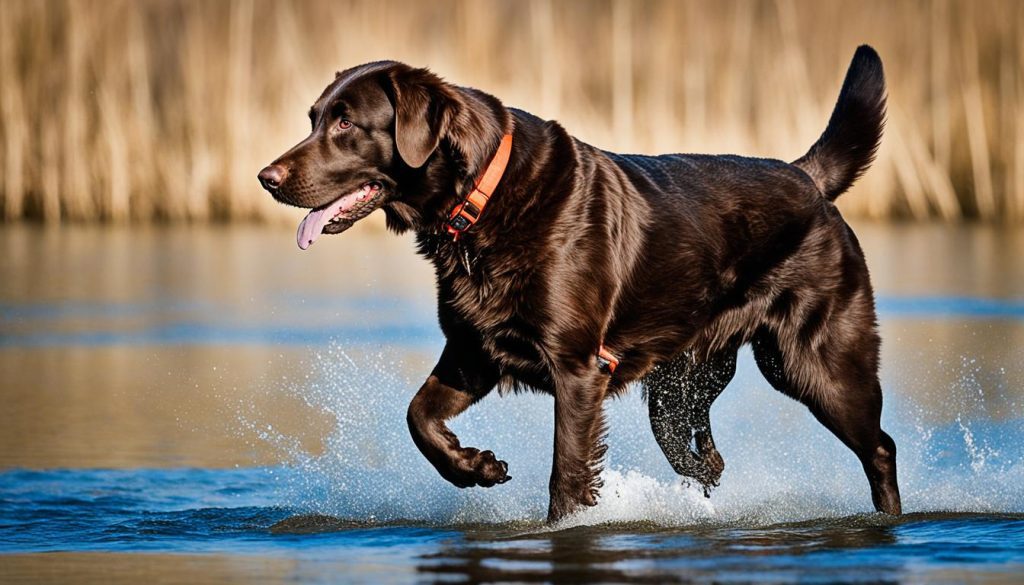When it comes to intelligence, Chesapeake Bay Retrievers are a breed worth exploring. Known for their exceptional hunting and retrieving abilities, these dogs showcase remarkable cognitive abilities and a high level of intelligence. If you’re wondering “are Chesapeake Bay Retrievers smart?”, the answer is a resounding yes.
Chesapeake Bay Retrievers are considered one of the smartest dog breeds, particularly among retrievers. Their intelligence can be attributed to their sharp instincts, keen sense of smell, and natural problem-solving skills. These cognitive abilities make them excellent working dogs, as well as beloved companions for families.
Understanding the intelligence of Chesapeake Bay Retrievers goes beyond just their ability to learn commands. These dogs are known for their adaptability and versatility, making them quick learners in a variety of contexts. Whether it’s training for agility, obedience, or tasks related to their hunting instincts, Chesapeake Bay Retrievers excel in their ability to grasp new concepts and perform tasks with precision.
For families looking for smart dogs to join their households, Chesapeake Bay Retrievers are an excellent choice. Their intelligence not only allows them to be quick learners, but it also enables them to form strong bonds with their human family members. These dogs are known for their loyalty and affection, particularly towards children, making them ideal companions for families.
When it comes to training smart dogs like Chesapeake Bay Retrievers, consistency and positive reinforcement are key. These intelligent canines thrive when their minds are stimulated, so providing them with regular mental challenges and training sessions is essential. With proper training and socialization, Chesapeake Bay Retrievers can become well-behaved and obedient pets.
Chesapeake Bay Retrievers are not only intelligent but also versatile and affectionate. Whether you’re looking for a hardworking companion or a loving family pet, these smart dogs are sure to exceed expectations.
Are Chesapeake Bay Retrievers Smart?
- Chesapeake Bay Retrievers are highly intelligent dogs, known for their exceptional hunting and retrieving abilities.
- These dogs showcase sharp instincts, a keen sense of smell, and natural problem-solving skills.
- Chesapeake Bay Retrievers are one of the smartest dog breeds, particularly among retrievers.
- Their intelligence allows them to excel in various training activities and form strong bonds with their human family members.
- Consistency, positive reinforcement, and mental stimulation are crucial for training smart dogs like Chesapeake Bay Retrievers.
The Characteristics of Chesapeake Bay Retrievers
The Chesapeake Bay Retriever is a medium to large-sized dog with a muscular and well-balanced build. They have a thick, oily double coat that is water-resistant, which is ideal for their working conditions. The breed comes in solid brown, sedge, or deadgrass colors.
Chesapeake Bay Retrievers are known for their loyalty, intelligence, and trainability. They have a love for water and retrieving, which is why they excel in hunting and water activities. Regular exercise, especially swimming, is essential for their physical and mental well-being.
Training Chesapeake Bay Retrievers can be relatively easy, though they can be stubborn at times. Early socialization and training are recommended to ensure they develop proper behavior. Grooming is relatively low-maintenance, with regular brushing to keep their coat healthy.
While they are generally healthy, they may be prone to hip dysplasia and elbow dysplasia.
Size and Proportion of Chesapeake Bay Retrievers
Chesapeake Bay Retrievers are medium to large-sized dogs, with males measuring 23 to 26 inches in height and weighing 65 to 80 pounds, and females measuring 21 to 24 inches in height and weighing 55 to 70 pounds. It is important to note that oversized or undersized animals are severely penalized.
The breed should have a well-proportioned body, with the height slightly less than the body length. The depth of the body should extend at least to the elbow, and the shoulder to elbow and elbow to ground should be equal. The Chesapeake Bay Retriever should have a strong and powerful chest but should not appear excessive or ponderous. Moderation is key, as this breed is a working retriever of an active nature.
Head and Coat of Chesapeake Bay Retrievers
The Chesapeake Bay Retriever is known for its unique head shape and distinct coat. Let’s delve into the details of their head structure, eyes, ears, and coat characteristics.
Head Structure
The head of a Chesapeake Bay Retriever features a broad and round skull, giving them a strong and powerful appearance. They have a medium stop, which is the indentation between the skull and the muzzle. This breed possesses sufficient jaw length and strength, making them capable of carrying large game birds with ease.
Eyes and Ears
The eyes of Chesapeake Bay Retrievers are striking and captivating. They are very clear and come in a yellowish or amber hue, adding to their charm. Their ears are small and set well up on the head, hanging loosely. This placement allows them to maintain a sleek and streamlined profile.
Coat Characteristics
The coat of a Chesapeake Bay Retriever is a defining feature that aids in their work as water retrievers. They have a short, harsh, and wavy outer coat that provides protection against water, cold temperatures, and icy conditions. Beneath the outer coat lies a dense fine wooly undercoat that adds insulation and further enhances their ability to withstand harsh environments. This double coat combination makes them well-suited for their hunting and retrieving duties.

Color Variety
The Chesapeake Bay Retriever comes in various shades of brown, sedge, or deadgrass, contributing to their distinctive appearance. These colors match their working surroundings and provide camouflage when out in the field. It’s important to note that while the breed generally has a solid coat color, limited white spots are allowed on the breast, belly, toes, or back of the feet.
Temperament and Training of Chesapeake Bay Retrievers
Chesapeake Bay Retrievers are known for their bright and happy disposition, intelligence, and affectionate protective nature. They can make excellent family dogs when properly socialized. While some Chesapeake Bay Retrievers may be reserved with strangers, others are more outgoing.
Training a Chesapeake Bay Retriever requires consistency and positive reinforcement. They are intelligent and learn at a high speed, but they may be stubborn at times. Obedience training and early socialization are crucial to shape their behavior and ensure they become well-adjusted members of the family. Chesapeake Bay Retrievers are versatile dogs that can compete in various activities such as field trials, hunt tests, conformation, obedience, agility, and tracking, all while staying true to their hunting instincts.

When it comes to temperament, Chesapeake Bay Retrievers are known for their bright and happy disposition, making them delightful companions.
They are intelligent dogs that are eager to learn and please their owners. However, they can also be quite stubborn, so consistent and positive reinforcement training methods work best with this breed. Early obedience training and socialization are essential to ensure they develop into well-behaved and well-adjusted dogs.
Chesapeake Bay Retrievers are loving and affectionate towards their families and are known for their protective nature. They form strong bonds with their owners and are often gentle and patient with children. However, they can be reserved or aloof with strangers, making them excellent watchdogs.
It is important to provide Chesapeake Bay Retrievers with mental and physical stimulation to keep them happy and fulfilled. They thrive on activities that engage their natural hunting instincts like retrieving games, tracking, and agility training. Regular exercise is essential for their overall well-being, and swimming is particularly beneficial for them, considering their love for water.
Obedience Training for Chesapeake Bay Retrievers
When training a Chesapeake Bay Retriever, it’s important to focus on positive reinforcement techniques to encourage good behavior. Their intelligence and eagerness to please make them quick learners, but patience and consistency are vital in their training process.
Obedience training should start early to establish good habits and prevent any potential behavioral issues. Commands such as sit, stay, down, and recall are essential for an obedient and well-behaved Chesapeake Bay Retriever.
Socialization of Chesapeake Bay Retrievers
Socialization is a crucial aspect of raising a well-adjusted Chesapeake Bay Retriever. It involves exposing the dog to various people, animals, and environments from a young age to create a confident and friendly temperament.
Early socialization helps prevent fear, aggression, and other behavioral problems that may arise from a lack of exposure to different stimuli. Introducing your Chesapeake Bay Retriever to different places, experiences, and individuals should be done in a positive and controlled manner, ensuring positive associations are formed.
| Training Tips for Chesapeake Bay Retrievers | Obedience Commands |
|---|---|
| Use positive reinforcement techniques such as treats, praise, and play to motivate and reward your Chesapeake Bay Retriever during training sessions. | Sit |
| Keep training sessions short and engaging to maintain your dog’s focus and prevent boredom. | Stay |
| Be consistent in your commands and expectations, using clear and concise language. | Down |
| Practice obedience commands in various environments and with different distractions to ensure your Chesapeake Bay Retriever can perform reliably in any situation. | Recall |
| Seek professional training assistance if needed, especially for behavioral issues or advanced training goals. |
Health of Chesapeake Bay Retrievers
Like all breeds, Chesapeake Bay Retrievers are subject to certain hereditary diseases. It is important for owners and breeders to be aware of these common health issues in Chesapeake Bay Retrievers to ensure the well-being of these beloved dogs.
Exercise-Induced Collapse
Exercise-induced collapse is a condition that affects some Chesapeake Bay Retrievers. It is characterized by a loss of muscle control and coordination during or after strenuous exercise. While it can be concerning, affected dogs usually recover on their own after a period of rest. It is important to monitor their activity levels and avoid excessive exercise to prevent episodes of collapse.
Hip Dysplasia
Hip dysplasia is a common orthopedic condition in Chesapeake Bay Retrievers. It occurs when the hip joint develops abnormally, leading to pain, stiffness, and difficulty in movement. Regular exercise, a balanced diet, and maintaining a healthy weight can help reduce the risk of hip dysplasia. Screening breeding dogs for hip dysplasia before breeding can also help minimize the prevalence of this condition.
Progressive Retinal Atrophy
Progressive retinal atrophy is an inherited eye disease that causes the degeneration of the retina, leading to vision loss and eventual blindness. Regular eye examinations by a veterinary ophthalmologist can help detect early signs of this condition. While there is no cure for progressive retinal atrophy, early detection allows for proactive management and support for affected Chesapeake Bay Retrievers.
Von Willebrand Disease
Von Willebrand disease is a blood clotting disorder that can affect Chesapeake Bay Retrievers. Dogs with this condition have a deficiency or abnormality in a clotting protein called von Willebrand factor. It can cause excessive bleeding and difficulty in clotting. Avoiding unnecessary surgical procedures and working closely with a veterinarian to manage bleeding episodes is crucial for dogs with von Willebrand disease.
Cataract
Cataracts are a common eye condition in Chesapeake Bay Retrievers. They cause clouding of the lens, leading to impaired vision. Regular eye examinations can help detect cataracts early on and enable timely intervention. In some cases, surgery may be necessary to remove the cataracts and restore vision.
Regional Alopecia
Regional alopecia, also known as seasonal flank alopecia, is a skin condition that can affect Chesapeake Bay Retrievers. It causes patches of hair loss, usually on the sides of the dog’s body. While the exact cause is unknown, it is believed to be linked to seasonal changes in hormone levels. Management may include dietary adjustments, hormone therapy, and providing a comfortable environment for the affected dog.
Lifespan of Chesapeake Bay Retrievers
The median lifespan of Chesapeake Bay Retrievers is around 10 to 13 years, with some living up to 13 years or more. Proper diet, regular exercise, routine veterinary care, and a loving environment can contribute to their overall health and longevity.
Regular veterinary check-ups, responsible breeding practices, and awareness of these common health issues can help ensure that Chesapeake Bay Retrievers live happy, healthy lives. By understanding and addressing these potential concerns, owners and breeders can make informed decisions to support the well-being of this remarkable breed.
Conclusion
Chesapeake Bay Retrievers are highly intelligent and versatile dogs that possess a unique set of characteristics, making them exceptional in hunting and retrieving activities. With their exceptional tracking abilities, these dogs are capable of locating game even in challenging environments. Moreover, their loyalty and affectionate nature make them not only excellent working dogs but also beloved family companions.
While Chesapeake Bay Retrievers may have specific care requirements and potential health issues, they can thrive in various environments with proper training, socialization, and care. Regular exercise and mental stimulation are essential to keep these energetic dogs happy and healthy. Activities like retrieving games, agility training, and obedience work strengthen the bond between owner and dog.
Ultimately, Chesapeake Bay Retrievers can become valued members of any family or working team. Their intelligence, versatility, and loving temperament make them a great choice for those seeking a companion that excels in both work and play. With the right guidance and care, these remarkable dogs can thrive and enrich the lives of their owners.






